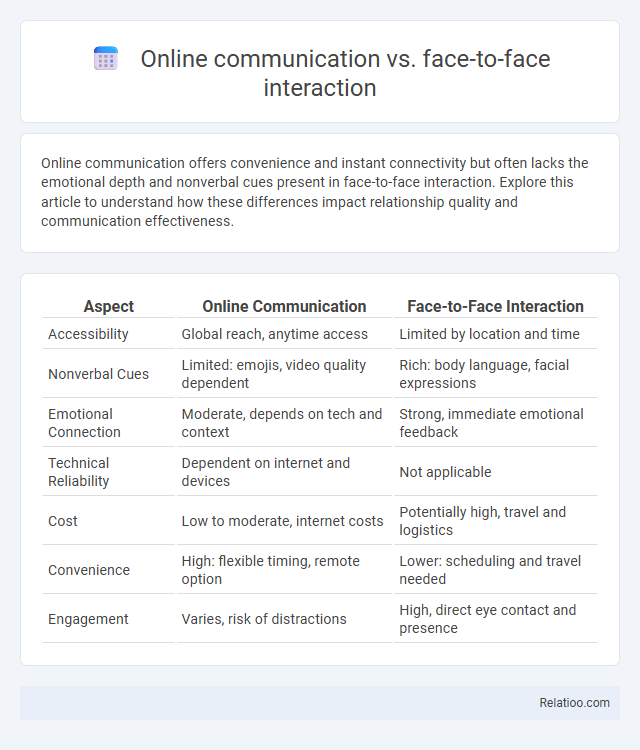Online communication offers convenience and instant connectivity but often lacks the emotional depth and nonverbal cues present in face-to-face interaction. Explore this article to understand how these differences impact relationship quality and communication effectiveness.
Table of Comparison
| Aspect | Online Communication | Face-to-Face Interaction |
|---|---|---|
| Accessibility | Global reach, anytime access | Limited by location and time |
| Nonverbal Cues | Limited: emojis, video quality dependent | Rich: body language, facial expressions |
| Emotional Connection | Moderate, depends on tech and context | Strong, immediate emotional feedback |
| Technical Reliability | Dependent on internet and devices | Not applicable |
| Cost | Low to moderate, internet costs | Potentially high, travel and logistics |
| Convenience | High: flexible timing, remote option | Lower: scheduling and travel needed |
| Engagement | Varies, risk of distractions | High, direct eye contact and presence |
Introduction to Online Communication vs. Face-to-Face Interaction
Online communication leverages digital platforms to connect individuals regardless of physical distance, offering convenience and immediacy in conversations. Face-to-face interaction facilitates richer emotional exchange and nonverbal cues that enhance understanding and relationship building. Your choice between these modes impacts the quality and depth of social connections, influenced by the significance of proximity in communication dynamics.
Key Differences Between Digital and In-Person Communication
Online communication relies on digital platforms enabling instant interaction across distances but often lacks nonverbal cues such as body language and facial expressions crucial for emotional understanding. Face-to-face interaction facilitates immediate feedback, richer emotional exchange, and stronger trust-building through physical presence and contextual awareness. Proximity enhances communication effectiveness by allowing spontaneous dialogue and multi-sensory engagement, which digital communication cannot fully replicate, impacting relationship depth and collaboration quality.
Psychological Impact of Virtual vs. Direct Conversations
Online communication offers convenience but often lacks essential nonverbal cues critical for emotional understanding, impacting the depth of psychological connection. Face-to-face interaction provides richer sensory feedback through body language and facial expressions, fostering greater empathy and trust in your conversations. Proximity enhances these effects by enabling immediate, intuitive responses, which promote stronger social bonds and reduce feelings of loneliness compared to virtual exchanges.
Advantages of Online Communication Platforms
Online communication platforms offer unparalleled convenience and accessibility, enabling You to connect instantly with people across the globe without geographical limitations. These platforms support multimedia sharing, real-time collaboration, and asynchronous communication, enhancing productivity and engagement beyond traditional face-to-face interactions. Their scalability and cost-effectiveness provide significant advantages for both personal and professional communication needs.
Benefits of Face-to-Face Interaction
Face-to-face interaction enhances communication through non-verbal cues like body language and facial expressions, providing richer context and emotional connection compared to online communication. Proximity fosters immediacy and trust, enabling spontaneous feedback and deeper relationship building. Your ability to read subtle social signals in person leads to more effective collaboration and stronger interpersonal bonds.
Challenges and Limitations of Digital Communication
Digital communication faces challenges such as limited nonverbal cues, which reduces emotional depth and can lead to misunderstandings compared to face-to-face interaction. Proximity enhances communication through subtle body language and immediate feedback that online platforms struggle to replicate. Technical issues, time zone differences, and digital fatigue further limit the effectiveness of online conversations.
Miscommunication Risks: Online vs. In-Person Exchanges
Miscommunication risks vary significantly between online communication and face-to-face interaction, with online exchanges more prone to misunderstandings due to lack of nonverbal cues such as body language and tone. Proximity in in-person communication allows for immediate feedback and clarification, reducing the chance of misinterpretation. Your ability to interpret facial expressions and vocal nuances in face-to-face conversations helps prevent errors that often occur in text-based or virtual communications.
The Role of Nonverbal Cues in Effective Communication
Nonverbal cues such as facial expressions, body language, and eye contact play a crucial role in effective communication by conveying emotions and intentions beyond words, which online communication often lacks due to limited visual and auditory feedback. Face-to-face interaction allows for a richer exchange of these cues, enhancing understanding and reducing misunderstandings through immediate and dynamic responses. Your ability to interpret and respond to these nonverbal signals significantly influences the clarity and emotional depth of your communication across different interaction settings.
Social Connection and Relationship Building in Both Mediums
Face-to-face interaction fosters deeper social connection and relationship building through nonverbal cues and immediate feedback, strengthening emotional bonds. Online communication provides convenience and accessibility, allowing You to maintain relationships across distances but may lack the richness of physical presence. Proximity enhances opportunities for spontaneous interactions, making it easier to develop trust and collaboration in both personal and professional settings.
Future Trends: Balancing Online and Offline Communication
Future trends in communication emphasize a hybrid approach balancing online communication and face-to-face interaction to maximize connectivity and relationship quality. Advances in augmented reality (AR) and virtual reality (VR) will enhance virtual presence, making online communication more immersive and socially meaningful. Proximity remains crucial for spontaneous and nuanced social cues, but digital platforms will increasingly complement physical interactions to support diverse social needs and work environments.

Infographic: Online communication vs face-to-face interaction
 relatioo.com
relatioo.com